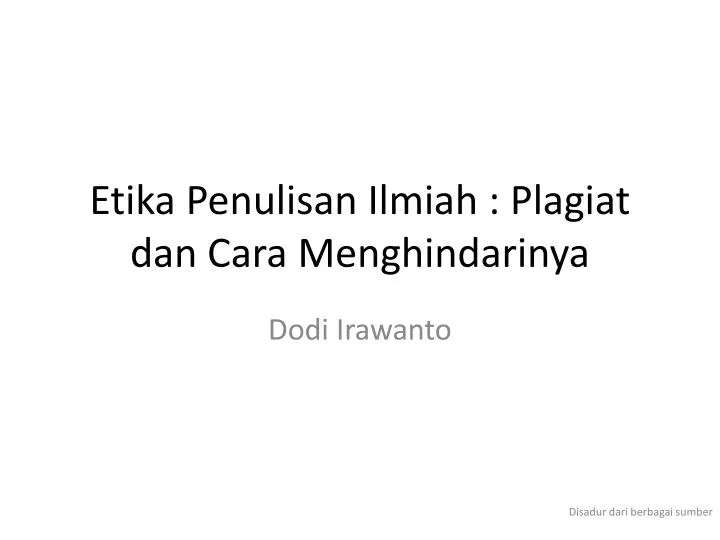
181 likes | 982 Views
Etika Penulisan Ilmiah : Plagiat dan Cara Menghindarinya. Dodi Irawanto. Disadur dari berbagai sumber. Etika Penulisan. Pelanggaran kode etik (penulis & tulisan). Etika - K onsep yang mengar ah pada perilaku yang baik dan pantas

E N D
Etika Penulisan Ilmiah : Plagiat dan Cara Menghindarinya DodiIrawanto Disadurdariberbagaisumber
Etika Penulisan • Pelanggaran kode etik (penulis & tulisan). Etika - Konsep yang mengarah padaperilaku yang baik dan pantas Terkait dengan moralitas, pranata,norma, baiksosial maupunnorma-normalainya (agama, akademik, dll) • Menjunjung tinggi hak, pendapat atau temuan orang lain. • Menyadari sepenuhnya untuk tidak melakukan pelanggaran ilmiah. • Pelanggaran tersebut diantaranya: - Falsifikasi - Fabrikasi - Plagiarisme
Plagiarisme :definisi • Kata “plagiarism” berasaldaribahasalatin Latin plagiarus yang artinya “kidnapper” • Plagiarism dapatdiartikan “the appropriation of another person’s ideas, processes, results, or words without giving appropriate credit” • Menurut Merriam Webster Dictionary dapatdiartikan :“transitive senses” : to steal and pass off (the ideas or words of another) as one's own : use (another's production) without crediting the source“intransitive senses” : to commit literary theft : present as new and original an idea or product derived from an existing source • Permen No 17 Tahun 2010 Plagiat adalah perbuatan secara sengaja atau tidak sengaja dalam memperoleh atau mencoba memperoleh kredit atau nilai untuk suatu karya ilmiah, dengan mengutip sebagian tatu seluruh karya dan/atau karya ilmiah pihak lain, diakui sebagaai karya ilmiahnya tanpa menyatakan sumber secara tepat dan memadai.
Konteks Plagiarisme • Substansi • Aspekkesengajaan • Proporsi/persentase • Kombinasiberbagaisumber • Auto/self plagiarism • Fabrikasi • Falsifikasi Fragmented Publication
Sengaja Mengcopypekerjaanorang lain Menggunakanjasapenulis Copy paste text darisumberelektroniktanpamendokumentasikannya TidakSengaja Farafrase yang tidakmencukupi Dokumentasidokumen yang tidakmencukupi Meng “quote” berlebihan Kegagalandalammenggunakanideandasendiri Jenis Plagiat
Cara Menghindari Plagiat • Memakai, menganalisa, membahas, mengritik atau merujuk hasil karya intelektual orang lain boleh dilakukan selama kaidah pemakaiannya tetap ‘proporsional’ • Rangkumlah hasil karya orang lain, atau melakukan parafrase pada bagian khusus dalam teks dengan cara penguraian menggunakan kata-kata sendiri, sertacantumkansumber gagasan dan masukkan dalamdaftarpustaka • Lebih aman gunakan kata-kata asli penulis juga dengan cara memberi tanda kutip pada kalimat-kalimat yang dipakai, selain menyebutkan sumber gagasannya.
1. Farafrase Paraphrasing means “rephrasing the words of an author, putting his/her thoughts in your own words.” When you paraphrase, you rework the source’s ideas, words, phrases, and sentence structures with your own. Like quotations, paraphrased material must be followed with in-text documentation and cited on your Works-Cited page. GunakanFarafrase : • Idetersebutpentingdanandainginmenghindaridariplagiat • Andainginmenghindari “quote” berlebihan • Andainginmenunjukkanide original anda
Contoh Source: Unless steps are taken to provide a predictable and stable energy supply in the face of growing demand, the nation may be in danger of sudden power losses or even extended blackouts, thus damaging our industrial and information-based economies. – John Doe, 1999, p.231. Inadequate paraphrase: Doe (1999) recommends that the government take action to provide a predictable and stable energy supply because of constantly growing demand. Otherwise, we may be in danger of losing power or even experiencing extended blackouts. These circumstances could damage our industrial and information-based economy. (p.231). • Proper paraphrase :Doe (1999) believes that we must find a more reliable source of energy if we are to have a dependable electricity supply. Without this, the nation’s economic base may be damaged by blackouts (p.231).
2. Quoting Quotations are the exact words of an author, copied directly from a source, word for word. Quotations must be cited! Gunakan quotations dalamkeadaan • Menambahkan” power dariargumenanda • Inginmenunjukkanketidaksetujuan (tidak support) terhadappekerjaanorang lain • Ingin “menggarisbawahi” argument andadidukungolehpekerjaanorang lain • Inginmengkomparasipendapatkontrasdaripekerjaananda • Inginmenunjukkanbahwapekerjaanandasudahmendahuluipekerjaanorang lain
Contoh • An englobe is “a layer colored clay applied to the surface of a piece of pottery to change its color” (Rhodes, 1963, p. 160). Rhodes (1963) defines an englobe as “a layer of colored clay applied to the surface of a piece of pottery to change its color” (p. 160). 40 words or more Rhodes (1963) discusses another approach to glazing: “An englobe, or a slip, is layer of colored clay applied to the surface of a piece of pottery to change its color or to add some decorative accent. There are many ways of developing, coloring, aging, and applying englobes”.(p. 160)
Mesin Plagiarism Base Online • http://www.dustball.com/cs/plagiarism.checker/ • http://smallseotools.com/plagiarism-checker/ • http://www.plagscan.com/seesources/analyse.php • http://www.scanmyessay.com/ Link Untuk Menulis Bebas Plagiat • http://luk.tsipil.ugm.ac.id/acu/ • http://www.nwmissouri.edu/library/services/plagtips.htm
Sumber Powerpoint Brannon, Joyce. Plagiarism: Giving credit when credit is due. PPT online source Neville C. Plagiarism. Dalam: The complete guide to referencing and avoiding Plagiarism. New York: Open University Press, the McGraw-Hill; 2007. p. 27-41. Rifai, Mien A. Pegangan Gaya Penulisan, Penyuntingan dan Penerbitan Karya Ilmiah Indonesia. Yogyakarta:Gadjah Mada University Press; cet. 4. 2004. Suryono, Isnani A.S. “Plagiarisme dalam Penulisan Makalah Ilmiah”. Naskah tidak diterbitkan. Setiawan, Nurkholis. “KedeEtikPenulisdanPenulisan”. Naskahtidakditerbitkan
